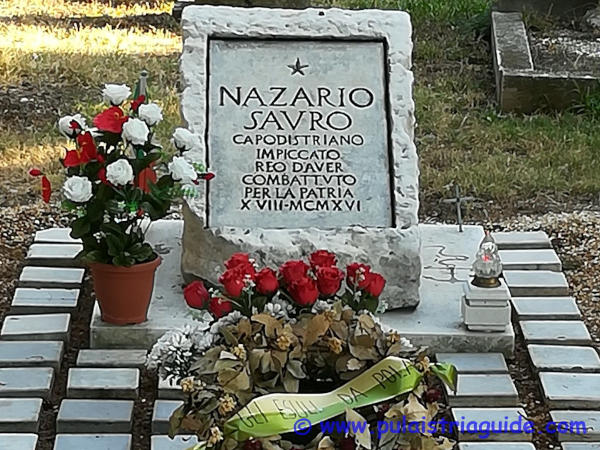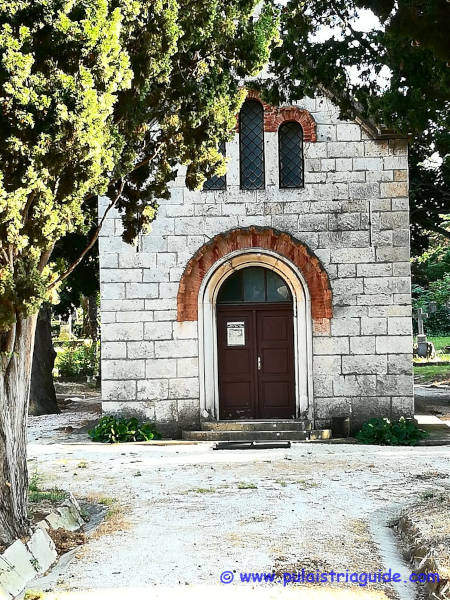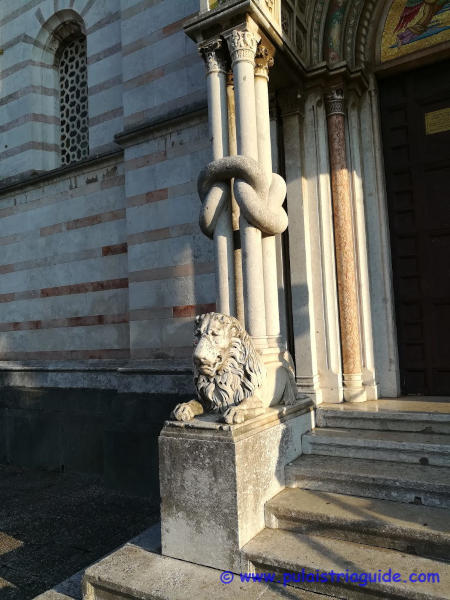The Navy cemetery of city of Pula
Certainly it is not the first place you go visiting when in a new city, but I have to admit, cemeteries are charming. The old ones, a bit decadent but well preserved, surrounded by greenery and tranquility have something mysterious and suggestive. Cities like Milan, London and Paris have their monumental cemeteries. Pula has one as well. The monumental Navy cemetery in Pula has been listed among the monuments under the protection of Hague Convention. Founded in 1862, with the name of K. u. K. Marinefriedhof, or Imperial and Royal Cemetery of the Navy today covers 22,000 square meters. Around 150,000 people had been buried until 1960. Like many works from the late 1800s to early 1900s, this one also was commissioned by the Austro-Hungarian Empire to bury its sailors stationed in Pula and then to bury first the Italian victims at sea and then the ones from Yugoslavia.

As in all cemeteries, also in the monumental ones behind the rows of tombs and tombstones there are hidden stories. Sad love stories, family stories, stories of war and of friendship and even of hate. The Navy cemetery dates back to the 60s of the 19th century. In those years Pula was under the Austro-Hungarian Empire and had become the Adriatic stronghold of the Austro-Hungarian Navy. Boats, admirals, sailors and simple people had been brought to Pula from Triest just in few years. More than 20 defensive fortresses had been built at that time and Pula got the attribute of "fortified city. From a thousand people in the early 1800s, on the threshold of the First World War, Pula grew to more then 60,000 inhabitants. The cemetery initially occupied an area of 4.000 square meters in Valkane, near Stoja but over the years it expanded to include the surrounding land up to today's extension of approximately 22.000 square meters.

If you take a walk in this cemetery you can find tombs with epitaphs in German, Italian, Croatian, Hungarian and also in Turkish and some "celebrities" of maritime history are also buried here. Anton Bourguignon von Baumberg, commander of the Austro-Hungarian Navy was buried here in 1879, the vice admiral KarlGgraf Lanjus von Wellenburg, was buried in 1913, and Janko Vukovic Podkapelski, was buried in 1918. It was the first burial cemetery of the irredentists Nazario Sauro and Giovanni Grion, afterwards transferred to the Venice cemetery. It gathers the victims of some sea tragedies that in the past years affected the whole Istrian and Italian population.

In this place lie the two Istrian sailors of the Italian submarine F14, protagonist of a tragedy that shook all Pula’s citizenship, always sensitive to the stories that come from the sea.
The tragedy of the submarine F14
In 1928 the submarine was used in an exercise by the Italian Royal Navy in the waters outside Pula. At that time Istria and other areas of Croatia were under Italian domination. By mistake the submarine emerged under the bow of the destroyer "Missori" which rammed it. The submarine quickly dived into a 40 meter deep water. The other ships used in the exercises provided help and other aid came from nearby Pula. After almost 12 hours of military radio communications but of dramatic intensity, radio silence occurred. The submarine was brought back to the surface the day after, but unfortunately there were no survivors among the 27 crew members who died of high concentrations of chlorine in the air.
La storia della Viribus Unitis
Another sad story that happened in Pula and which victims can be found in the monumental cemetery, is the tragedy of the Austro-Hungarian battleship "Viribus unitis". Moored in the armored port of Pula, it became the protagonist of what is known in the military world as the Raid on Pula, a sabotage action with dramatic and surreal implications.

It was November 1st 1918 and some ships of the Italian Navy approached the port of Pula with the aim of sabotaging enemy ships moored in the bay. The bay of Pula, as already mentioned, was considered impregnable but was nevertheless among the objectives of the Italian Navy. In addition to the fortresses and batteries present on land, the entrance to the port was protected with mines and three orders of defensive networks spread in the sea. The Italian ships had to stop in a protected area outside the port, out of sight of the Austro-Hungarian sentries. Two Italian SWATs, the naval engineer Raffaele Rossetti and the medical lieutenant Raffaele Paolucci on board a small military vessel, a "Mignatta", headed for the "Viribus Unitis". The controls and barriers were so effective that the two SWATs had to go on with the engines off with the “Mignatta” loaded with explosives towards the target. They managed to place the explosive, which however did not trigger the explosion due to some problems. While the two saboteurs were fleeing they were spotted and captured by the military on guard. To their amazement the two Italian saboteurs were treated friendly by the soldiers who took them over. The amazement for the treatment reserved for them, was also for that the "enemy" soldiers did not have the Austro-Hungarian uniform, but that of the new state of the Slovenes, Serbs and Croats, and that the warship did not fly the imperial flag but the tricolor of Yugoslavia. The two Italians discovered during the interrogation that the day before, on October 31st, the Austro-Hungarian Navy surrendered and delivered the port and the ships to the Yugoslav navy. A few days later the communication that the war would end with the signing of the surrender of Austro-Hungarians to Italy on November 3, 1918 would also arrive. At the news, officer Rossetti warned the soldiers of the Slavic state that the Viribus Unitis was full of explosive triggered but not detonated. The Yugoslav soldiers after an initial evacuation on the sister ship Tagetthoff and finding nothing on the Baron Gautsch, decided to return on the ship. Shortly after the charge shone opening a gash and making the battleship tilt on its side and sink. The action killed over 300 people, some of whom were buried in the Navy cemetery in Pula. The commander Janko Vukovic Podkapelski who with his fleet commanded Viribus Unitis for about 12 hours, died in this tragedy.
The Titanic of the Adriatic sea, the Baron Gautsch tragedy
Not only soldiers are buried in the Navy cemetery in Pula. Among its tombstones it is also possible to find victims of what, together with the Titanic, was one of the most atrocious naval tragedy with civilian victims. The Baron Gautsch, former military ship was used in 1918 as a civilian ship to connect the port of Mali Lošinj to Trieste. On August 13th 1914 the ship was heading to Trieste sailing under the coast when in the vicinity of Rovinj it entered an area mined by the Austro-Hungarian navy itself. Although helped in navigation by the Austrian minelayer, at 15.45 it hit a mine and sank in few minutes. Of the 300 people on board, 150 died at sea. The event shocked public opinion as the entire crew was saved at the expense of civilian passengers. It was documented that third-class passengers were unable to access the lifeboats unusable due to lack of maintenance. They couldn’t neither get life jackets because they were kept under lock so that the poor passengers could not use them as cushions during the journey. There was a long trial by which the accused officers were later acquitted and continued their careers without consequence. The dead in this tragedy are considered to be the first civilian victims of the First World War.

Baron Gautsch today is one of the most fascinating wrecks in the Adriatic and a destination for divers who visit what remains of this ship. The Navy cemetery in Pula is interesting because of that. It is a dive into history and the past and reminds us that history itself is made of people who worked, traveled, loved, quarreled and sometimes died in a senseless and unfair way.
Our Lady of the sea Church

In addition to the cemetery, the Austro-Hungarian Empire made another work that is still present in Pula today. The same Emperor of Austria, Francis Joseph I in 1891 carefully followed the works on the church Our Lady of the Sea, a tribute by the Empire to its mighty Navy. The church costed the empire a lot of money because they wanted it rich and showy. There are many references to the sea and the seafaring tradition (the columns with the sailor knot in the first place) and the church is decorated with golden mosaics that make one think of the Euphrasian Basilica in Porec and the cathedral of San Marco in Venice.

As very often happens in Pula, there is here too this sort of dichotomy which involves the coexistence of rich and beautiful works with dilapidated and decadent corners. In this case, the decadent aspect is given by the staircase that go from the church to the sea ... but that never gets there, never got there and that today lie at the foot of the church in vain. Probably the initial idea of the staircase can be understood by observing the mosaic above the vault of the altar.



